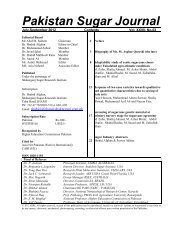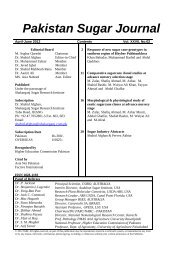Pakistan Sugar Journal
April-June 2010 - Shakarganj Group
April-June 2010 - Shakarganj Group
Create successful ePaper yourself
Turn your PDF publications into a flip-book with our unique Google optimized e-Paper software.
Millable Cane Density and Weight<br />
Millable cane density in an important yield attributing character and is the interaction of<br />
germination, tillering and tiller mortality. The mean cane stand differences were statistically<br />
significant as shown by the data embodied in table 2.<br />
September planted sole cane gave significantly high cane density of 102.78 thousand canes<br />
per hectare. It was matchingly followed by the sugarcane sown in March after harvesting<br />
raya. The sugarcane intercropped with raya sown either by gupchat or drill, reduced cane<br />
formation significantly. The depressing effect of raya on cane formation may be attributed to<br />
the corresponding lower tillering and relatively more tiller mortality due to shading effect of<br />
the intercrop. Similar conclusions have also been drawn by Aslam et al., (5) and Malik and<br />
Kamoka (8).<br />
The data recorded in table-1 for hundred cane weight reveal significant differences among the<br />
means of different treatments. The cane stalks planted in September either alone or with<br />
intercrops were heavier than the spring planted cane probably because of the prolonged<br />
growth period available to the former. The minimum hundred cane weight of 93.50kg was<br />
recorded for the cane planted after harvesting raya in March.<br />
Crop Yields<br />
The final crop yield is the ultimate goal of each and every grower. A perusal of the data given<br />
in table 2 exhibit that the differences among the means of cane yield in the treatments were<br />
statistically significant. Autumn planted alone sugarcane produced the highest cane<br />
yield(115.33t/ha). None of the other treatments could match it. The sugarcane intercropped<br />
with raya sown by drill method gave slightly more yield than the gupchat treatments but these<br />
were statistically at par with one another. <strong>Sugar</strong>cane planted after the harvest of raya in<br />
March gave the least tonnage of 95.60 per hectare. These yield losses were compensated by<br />
the additional harvests of intercrop. The "Khanpur Raya" when planted alone gave a produce<br />
of 2.37t/ha. The same variety of raya produced 2.1 It/ha when intercropped by gupchat<br />
method and 1.72t/ha when sown by drill method. The raya variety Anmol produced lower<br />
than Khanpur Raya in all the treatments. The yield results are quite in line to those of Aslam<br />
et al., (4), Chattha et al.,(7) and Malik and Kamoka(8).<br />
Economic Benefits<br />
The economics of different crop combinations worked out in terms of gross income, cost of<br />
production and net income is given in table-3. The data show that the gross income received<br />
from either of the intercropping combinations was higher than the alone cane sown in<br />
September. The highest gross income of Rs. 214.10 thousands per hectare has been calculated<br />
for sugarcane intercropped with "Khanpur Raya" by gupchat method followed by the<br />
sugarcane planted after harvesting Khanpur Raya (Rs.208.57 thousands /ha). Net income was<br />
also greater for sugarcane intercropped with "Khanpur Raya" by gupchat method. The EMV<br />
of all the intercropping treatments was greater than'T' which advocates the higher net returns<br />
from intercropping treatments. The highest EMVs of 1.51 and 1.42 show economic<br />
superiority of sugarcane + Khanpur Raya sown by gupchat and sugarcane sown after<br />
harvesting Khanpur raya, respectively. Similar economic gains due to intercropping have also<br />
been reported by Aslam et al.(2,3,4,5), Bahadar et al.(6) and Malik and Kamoka (8).






